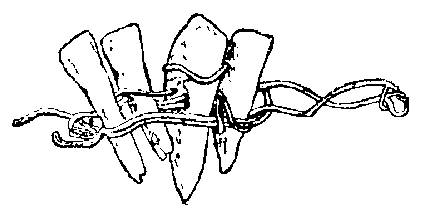
|
|||
|
[ Previous ][Contents][ Next ] |
|||
|
examinations of their various writings do not reveal any record of mechanical dental appliances for lost or weakened teeth or instructions for their manufacture. Volumes of medical and dental advice were written during this time, but interference consisted mostly of simple medical prescriptions similar to those recorded in Egypt. Extraction was resorted to only when the teeth were extremely loose. The Greeks prided themselves in their ability to withstand pain, so possibly did not consider a toothache a thing painful enough to warrant elimination of an organ as necessary to appearance as a tooth. This, together with their physical fitness due to their great love of athletics and athletic games, may explain the very few examples of restorative dentistry Among the well preserved archaeological remains of ancient Greece.  Fig. 2 Hippocrates and other later writers describe methods of wiring the teeth into their normal relationship with gold wire in cases of fractures of the jaw until the bones are healed. But we have no proof that these few detached examples of ancient Greek prosthetic dentistry may not be from patients with fractured jaws who have succumbed before the retaining wires were removed. The crude Greek appliances now existing (Fig. 2), which date from the 4th Century B.C., give us little reason to believe that they were of any assistance or could even have been tolerated well during normal mastication. (10) Superior to the Greek dentistry are, however, the two remaining examples of Phoenician dentistry even if they do not by any means measure up to the achievements of the Etruscan dentist. Both examples come from tombs in the neighborhood of Sidon. The first was found in 1862 by Renan's medical assistant, Gaillardot, and is now in the Louvre. It is described in the following way by Dr. Gaillardot:(11) "A part of the upper jaw of a woman with two canines and the four incisors united with gold wire. Two of the incisors would appear to have belonged to another individual and to have been applied as substitute for lost teeth. This piece discovered in one of the most ancient tombs of the necropolis proves that dental art in Sidon was sufficiently advanced." But certain inaccuracies in the original description by Renan and Gaillardot, first noticed by Guerini(12) coupled with the uncertainty |
|||
|
|||
|
[ Previous ][Contents][ Next ] |
|||
|
Created by the Digital
Documentation Center at AUB
in collaboration with Al
Mashriq of Høgskolen i
Østfold, Norway. 980519 pas - Email: hseeden@aub.edu.lb |